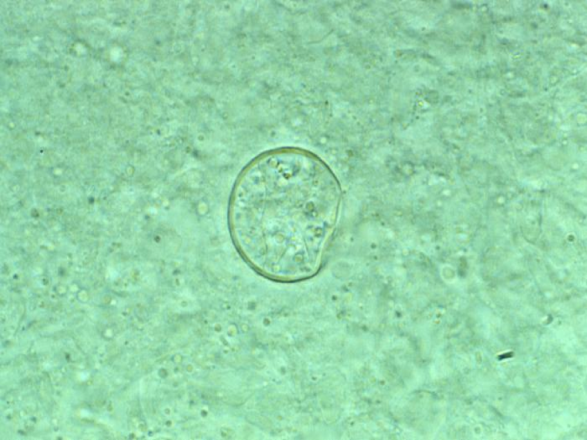30-year-old pregnant patient presents with contractions and vaginal bleeding
A 30-year-old gravida 1 para at 38 weeks of gestation presents to you with contractions and vaginal bleeding. She notes that she has filled a medium-sized sanitary napkin with blood in the past hour and that she feels painful contractions every 2 minutes. Electronic fetal monitoring and tocometry are started. Vital signs are: temperature 37 °C, heart rate 100 beats/minute, blood pressure 170/95 mm Hg, respiratory rate 20 breaths/minute, and oxygen saturation 99% on room air. Fetal heart tracing is 130 beats/minute with minimal variability and occasional late decelerations. Contractions are every 1 to 2 minutes.
Upon vaginal examination, you note dime-sized clots in the vaginal vault. Her cervical examination shows complete dilation, 100% effacement, and station +3/5. She feels an urge to push 5 minutes later and precipitously delivers a viable neonate, followed immediately by the placenta; it appears to have a large amount of adherent clot. The patient has several gushes of blood and expresses at least 500 cc of blood clots. While you evacuate more clots from inside her uterus, her brisk bleeding continues and more blood clots are expressed.
Vital signs are again obtained and are: temperature 37 °C, heart rate 120 beats/minute, blood pressure 85/55 mm Hg, respiratory rate 24 breaths/minute, and oxygen saturation 100% on 2 L oxygen by nasal cannula.
Which of the following is the next most appropriate step in management?
- Obtain a complete blood count (CBC) with platelets, prothrombin time (PT)/international normalized ratio (INR), partial thromboplastin time (PTT), and fibrinogen and transfuse based on the results.
- Start infusing crystalloid "wide open."
- Administer cryoprecipitate.
- Start transfusion of packed red blood cells (PRBCs), platelets, and fresh frozen plasma (FFP) in fixed ratios.
The correct answer is:
Start transfusion of packed red blood cells (PRBCs), platelets, and fresh frozen plasma (FFP) in fixed ratios.
Educational Objective:
Recognize and initially treat hemorrhagic shock.
Key Point:
Hemorrhagic shock accounts for nearly 25% of all maternal deaths. Early recognition, as well as prompt transfusion of blood products, improves a woman’s likelihood of survival following postpartum hemorrhage.
Explanation:
This patient is in hemorrhagic shock. Her presentation of vaginal bleeding, uterine hypertonicity, and delivery of a placenta with an adherent clot immediately after neonatal delivery suggest placental abruption. Maternal hypertension is a risk factor for abruption, and this patient did arrive hypertensive. She is experiencing postpartum hemorrhage based on both the historical criteria of estimated blood loss of at least 500 cc and the current definition of signs and symptoms of hypovolemia due to blood loss within 24 hours of delivery.
Tachycardia and hypotension only manifest with a 25% loss of total blood volume, which is roughly 1500 cc. Hemorrhagic shock is treated with source control, blood product replacement, and prevention/correction of coagulopathy. Delivery was source control in this patient’s case.
Early volume replacement with multiple blood components (PRBCs, FFP, platelets, cryoprecipitate) in fixed ratios reduces the risk of systemic inflammatory response syndrome, multiorgan dysfunction, and coagulopathy. Risk of maternal mortality decreases as a result.
The key to survival in hemorrhagic shock is early clinical recognition, and aggressive treatment and should not await the results of laboratory studies. Tests for blood typing and crossmatch, CBC, platelet count, PT/INR, PTT, an fibrinogen levels are all appropriate and necessary for guiding resuscitation during a massive transfusion. Additional tests should include ionized calcium and electrolyte levels due to the risks of transfusion-related hypocalcemia and hyperkalemia. Arterial blood gases and lactate levels are also helpful in guiding resuscitation.
Volume resuscitation with intravenous crystalloids is inappropriate due to the dilution of platelets and clotting factors. This dilution of these blood components in additional to their direct loss from bleeding can lead to coagulopathy. However, volume resuscitation with intravenous crystalloids is the appropriate initial treatment for patients in septic shock.
Cryoprecipitate contains concentrated fibrinogen, factors VIII and XIII, and von Willebrand factor. Although FFP contains fibrinogen and increases its level the same as cryoprecipitate, the smaller volume of cryoprecipitate (thus a shorter time of administration) is indicated when there is a need for a large amount of fibrinogen. Hyperfibrinogenemia (< 100 mg/dL) in the setting of continued bleeding warrants cryoprecipitate infusion. For conditions frequently associated with significant hyperfibrinogenemia, such as placental abruption or amniotic fluid embolism, use of cryoprecipitate should be anticipated, but it is not the first step in initial blood component replacement.
References:
American College of Obstetricians and Gynecologists. Postpartum hemorrhage. Practice bulletin no. 183. Obstet Gynecol. 2017;130:e168e-186.
Belfort MA. Disseminated intravascular coagulation during pregnancy. Accessed October 22, 2018.
Erez O, Mastrolia SA, Thachil J. Disseminated intravascular coagulation in pregnancy: insights in pathophysiology, diagnosis and management. Am J Obstet Gynecol. 2015;213:452-463.
Lee R, Shields S, Mason H, et al. Blood product replacement: obstetric hemorrhage. Accessed October 22, 2018.
Menard MK, Main EK, Currigan SM. Executive summary of the reVITALize initiative: standardizing obstetric data definitions. Obstet Gynecol. 2014;124:150-153.
Patil V, Shetmahajan M. Massive transfusion and massive transfusion protocol. Indian J Anaesth. 2014;58:590-595.
Rhodes A, Evans LE, Alhazzani W, et al. Surviving Sepsis Campaign: international guidelines for management of sepsis and septic shock: 2016. Intensive Care Med. 2017;43:304-377.
This question appears in Med-Challenger OBGYN Exam Review with CME
Try for free and save. Ace your exams and meet your CME/MOC requirements for just $26 a month!



